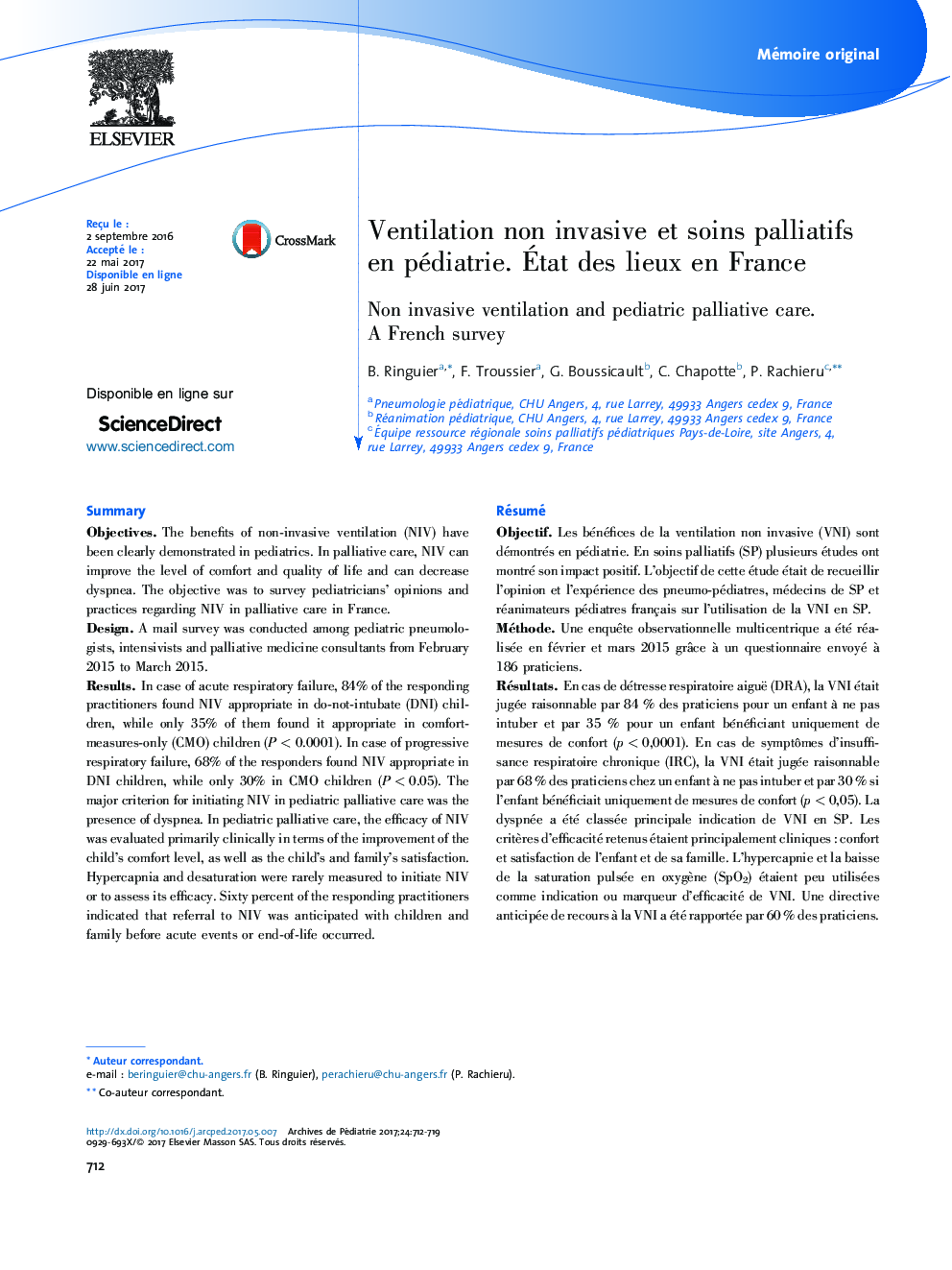| Article ID | Journal | Published Year | Pages | File Type |
|---|---|---|---|---|
| 5717311 | Archives de Pédiatrie | 2017 | 8 Pages |
RésuméObjectifLes bénéfices de la ventilation non invasive (VNI) sont démontrés en pédiatrie. En soins palliatifs (SP) plusieurs études ont montré son impact positif. L'objectif de cette étude était de recueillir l'opinion et l'expérience des pneumo-pédiatres, médecins de SP et réanimateurs pédiatres français sur l'utilisation de la VNI en SP.MéthodeUne enquête observationnelle multicentrique a été réalisée en février et mars 2015 grâce à un questionnaire envoyé à 186 praticiens.RésultatsEn cas de détresse respiratoire aiguë (DRA), la VNI était jugée raisonnable par 84 % des praticiens pour un enfant à ne pas intuber et par 35 % pour un enfant bénéficiant uniquement de mesures de confort (p < 0,0001). En cas de symptômes d'insuffisance respiratoire chronique (IRC), la VNI était jugée raisonnable par 68 % des praticiens chez un enfant à ne pas intuber et par 30 % si l'enfant bénéficiait uniquement de mesures de confort (p < 0,05). La dyspnée a été classée principale indication de VNI en SP. Les critères d'efficacité retenus étaient principalement cliniques : confort et satisfaction de l'enfant et de sa famille. L'hypercapnie et la baisse de la saturation pulsée en oxygène (SpO2) étaient peu utilisées comme indication ou marqueur d'efficacité de VNI. Une directive anticipée de recours à la VNI a été rapportée par 60 % des praticiens.ConclusionLes pédiatres français ont recours à la VNI en SP et ils considèrent ce traitement raisonnable pour les enfants à ne pas intuber. Les indications et critères d'efficacité sont essentiellement cliniques dans ce contexte.
SummaryObjectivesThe benefits of non-invasive ventilation (NIV) have been clearly demonstrated in pediatrics. In palliative care, NIV can improve the level of comfort and quality of life and can decrease dyspnea. The objective was to survey pediatricians' opinions and practices regarding NIV in palliative care in France.DesignA mail survey was conducted among pediatric pneumologists, intensivists and palliative medicine consultants from February 2015 to March 2015.ResultsIn case of acute respiratory failure, 84% of the responding practitioners found NIV appropriate in do-not-intubate (DNI) children, while only 35% of them found it appropriate in comfort-measures-only (CMO) children (PÂ <Â 0.0001). In case of progressive respiratory failure, 68% of the responders found NIV appropriate in DNI children, while only 30% in CMO children (PÂ <Â 0.05). The major criterion for initiating NIV in pediatric palliative care was the presence of dyspnea. In pediatric palliative care, the efficacy of NIV was evaluated primarily clinically in terms of the improvement of the child's comfort level, as well as the child's and family's satisfaction. Hypercapnia and desaturation were rarely measured to initiate NIV or to assess its efficacy. Sixty percent of the responding practitioners indicated that referral to NIV was anticipated with children and family before acute events or end-of-life occurred.ConclusionFrench pediatricians habitually use NIV for management of acute or progressive respiratory symptoms in DNI children. In CMO children, a majority of responding practitioners find NIV inappropriate. In palliative care, the indications for and efficacy of NIV are evaluated based on clinical criteria and rarely on gasometric criteria.
